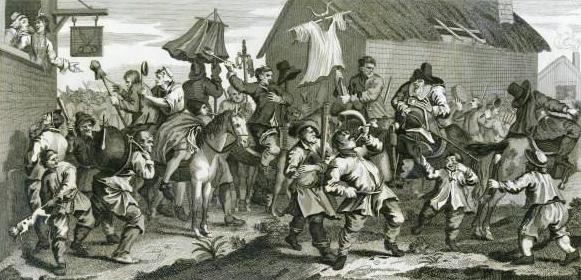Let us begin our view of symbolic expression in Framing-era law by looking at speech restrictions. We'll get to speech protections in coming posts, but the law of speech restrictions is relevant because speech restrictions and speech protections were seen as closely related during the era: The restrictions were recognized exceptions from the constitutional freedoms, and the freedoms were recognized as being constrained by the traditional restrictions.
Speech restriction law of the late 1700s and early 1800s took a functional view of symbolic expression, and generally treated it the same as verbal expression. As William Hawkins' Pleas of the Crown (1716) explained -- in language quoted in the famous American seditious libel trial of John Peter Zenger -- "[S]ince the plain meaning of [defamatory] scandal as is expressed by signs or pictures[] is as obvious to common sense, and as easily understood by every common capacity, and altogether as provoking, as that which is expressed by writing or printing, why should it not be equally criminal?"
We see this equivalence as early as Sir Edward Coke's report of De Libelli Famosis (1606):
Every infamous libel, [either is] in scriptis, [or] sine scriptis [i.e., without writing]; a scandalous libel in scriptis when an Epigram, Rhime, or other writing is composed or published to the scandal or contumely of another, by which his fame and dignity may be prejudiced. And such libel may be published, 1. Verbis aut cantilenis: As where it is maliciously repeated or sung in the presence of others. 2. Traditione, when the libel or copy of it is delivered over to scandalize the party. Famosus libellus sine scriptis may be, 1. Picturis, as to paint the party in any shameful and ignominious manner. 2. Signis, as to fix a Gallows, or other reproachful and ignominious signs at the parties door or elsewhere.
Later sources constantly repeated these two categories of symbolic expression to verbal expression. Blackstone's Commentaries (1765) defined libel to include "pictures, signs, and the like" alongside verbal expression; "signs" was a literal translation of Coke's "signis," apparently in the sense of "symbols," such as Coke's gallows. Hawkins' Pleas of the Crown took the same view as Blackstone. American sources, which often cited Blackstone and sometimes Hawkins, naturally followed suit. This meant libel law covered a wide range of symbolic actions, processions, and pictures, for instance:
- burning an effigy of a person,
- hanging an effigy of a person,
- engaging in a "procession carrying a representation of the plaintiff in effigy,"
- painting a man "with a fool's cap, or coat, or with horns, or . . . asses ears," or "playing at cudgels with his wife,"
- "placing a wooden gun at an officer's door, thereby implying cowardice,"
- hanging "Wool upon a Tree near the High-way, before the Plaintiff's Dwelling-house," which was understood to suggest that the plaintiff was a wool thief,
- lighting a lantern outside a person's house, implying the house was a brothel,
- "carrying a fellow about with horns, and bowing at [the plaintiff's] door," implying the plaintiff's wife is unfaithful,
- displaying an etching of plaintiff's head, with an iron nail driven into his ear and scissors attached to the nail, implying the plaintiff is a perjurer,
- and "riding Skimmington" (see the picture below), a "ludicrous cavalcade, in ridicule of a man beaten by his wife," consisting "of a man riding behind a woman, with his face to the horse's tail, holding a distaff in his hand, at which he seems to work, the woman all the while beating him with a ladle; a smock displayed on a staff is carried before them as an emblematical standard, denoting female superiority: they are accompanied by what is called the rough music, that is, frying-pans, bulls horns, marrow-bones and cleavers, &c."
 |
Symbolic expression and verbal expression were likewise equivalent under the law of sedition. They were equivalent under the law of obscenity, sometimes called "obscene libel": "In [obscenity law], as in private libels and slanders, the communication may be, not only by writings and words, but also by exhibitions, symbols, and pictures." They were equivalent under the law of slander, to the extent that some impromptu symbols were treated as tantamount to spoken slander (the examples above were of more elaborate symbols that were treated as tantamount to written libels).
And symbolic expression and verbal expression were equivalent under the law of blasphemy, or "blasphemous libel." Though blasphemy was generally seen as consisting of "oral or written" "words," a leading blasphemy case suggested the crime could equally be committed by burning an effigy of Jesus Christ; depicting the Virgin Mary as "naked . . . in the act of prostitution"; or, in a hypothetical majority Muslim or Jewish community, "gibbeting the image of the prophet," "burning the koran by the hands of the common hangman," "burning the prophets in effigy," or "maliciously stamping the pentateuch under foot."
Related Posts (on one page):
- "Freedom of Speech, or of the Press" as the "Right To Speak, To Write, or To Publish," Including Symbolic Expression:
- Symbolic Expression in Late 1700s and Early 1800s Discussions of Constitutional Law:
- Symbolic Expression in Late 1700s and Early 1800s Speech Restriction Law:
- A Brief Note on Symbolic Expression During the Framing Era:
- Symbolic Expression and the Original Meaning of the First Amendment: